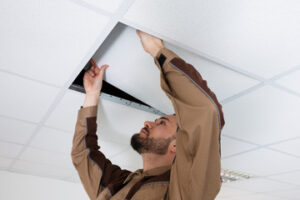Insulation Perth prevents heat from entering your home in the summer and keeps it inside in the winter. It can save you a lot of money on energy bills and improve your comfort at the same time.

Good insulation reduces thermal transfer through conduction, convection and radiation. Its effectiveness can be measured using U-value and R-Value.
Insulation is a crucial component in modern buildings and homes. It slows the transfer of heat between spaces, maximizing energy efficiency and comfort. However, the role of insulation is complex and requires a deep understanding of the physical properties that determine how it performs. It is important to understand the different methods of heat flow, such as conduction, convection, and radiation, in order to maximize the benefits of insulation products.
Conductive thermal energy moves along and through materials with differing temperatures, such as metals. Insulation materials are poor conductors of thermal energy because they have a large number of gaps and voids that trap air between atoms, which slows the movement of electrical charges in the material. This is why a material with many small air pockets (such as fiberglass) has a much lower rate of thermal conductivity than metals or plastics.
The resistance of an insulator to conductive thermal energy is known as its lambda value. The lower the lambda value of an insulating material, the higher its insulating ability. A material’s resistance to conduction is based on its thickness, density, and temperature, as well as how it ages over time.
A common problem with conductive thermal energy transfer is condensation, which can cause the insulation to lose its insulating capacity. In this case, the insulated surface must be kept dry to avoid moisture buildup. This can be achieved by limiting the contact surface area of the insulation and using an air barrier between it and the cold surface it is protecting.
In contrast to conduction, a radiant thermal energy transfers through electromagnetic waves, such as infrared light. This is why glass and translucent insulation materials are often used, as they allow the sun’s radiant heat to enter a space while blocking out harmful UV rays.
An insulation material’s ability to resist radiation is measured by its R-value, which varies depending on the type and thickness of the insulation and its density. R-values can also vary slightly due to age, temperature, and moisture accumulation. In addition, precision installation is important to maintain insulation’s effectiveness; gaps and compression decrease its R-value.
Convection
When air or water move through a building, they carry heat energy with them. Insulation works by slowing down or stopping this convection. The ability of a material to resist this flow is called its thermal conductivity (sometimes lambda value), and is dependent on the temperature, pressure, and type of material. Materials with low lambda values are effective insulators.
Convection can also occur when molecules within a substance change density as they warm up, causing them to rise and push on adjacent molecules. Insulation can be designed to inhibit convection by creating barriers that separate atoms and molecules from one another. This can be achieved by using materials with low thermal conductivity, or by designing structures that reduce the amount of exposed surfaces.
The insulating capability of a material is also determined by its resistance to the transfer of radiant energy. This is determined by the emissivity of the material, which refers to its ability to reflect or absorb radiation. The lower a material’s emissivity, the more it is able to reflect and absorb radiant energy. This is why a material with a reflective surface makes an effective insulation.
While all insulators are able to reduce transmission of these three types of heat energy, it is the combination of these that determines the overall insulating effectiveness of an installation. This in turn affects the thermal comfort of a building or structure. Heat moves from areas of higher temperature to those with a lower temperature, seeking a balance in the system; reducing the transmission of this heat through insulation is key to maximizing insulation’s efficiency and effectiveness.
The resistance of an insulator to the transfer of conductive heat is measured and rated in terms of its R-value. This is a function of the thickness and thermal conductivity of the insulation, as well as the material’s density and moisture content. For a multilayered installation, the R-value of each layer is added to determine the overall insulation’s efficacy. The R-values of different insulators are listed in tables that can be found online, and in technical publications from insulation manufacturers.
Vapor Barriers
Vapor Barriers are a vital part of any insulation installation. They are used to prevent moisture and condensation from entering wall cavities, especially in climate zones with extreme temperature differences. This is important because vapor can travel from warm to cold, just like air, and can become liquid water once it hits a cooler surface inside the wall cavity. This can lead to mold and mildew, and cause damage to the insulation, which will decrease its efficiency. Vapor barriers help keep this moisture out, and they allow any vapor that does find its way to escape.
The vapor barriers themselves are typically made of a thick plastic or foil sheet that has a perm rating (or “permeability” rating) between 0.1 and 10 perms. The low perm ratings mean that the water vapor can easily pass through, while the higher perms means that it will be much more difficult.
It’s important to know the difference between a vapor barrier and a vapor retarder, because the two are often confused by members of the building, construction, and design industries. The primary job of a vapor barrier is to keep moisture out, which is accomplished by having it installed on the outer face of the wall.
A vapor retarder, on the other hand, is intended to control both vapor movement and air movement, so it’s often placed between the sheathing and the exterior finish of the building envelope. These products tend to be less expensive than vapor barriers, but they aren’t as effective at keeping moisture out of the walls as they could be.
When you’re purchasing your insulation, it’s best to consult a professional to determine which type of product is best for your needs and location. The climate zone you live in will play a big role in whether or not you’ll need a vapor barrier, as well as the thickness of your chosen product. Your contractor will also be able to advise you on the type of barrier that will work best with any other materials your home may contain, such as chemically treated concrete or certain types of gypsum board and plaster.
Moisture Barriers
Moisture barriers are important for keeping insulation dry, and the benefits they provide go far beyond just helping keep energy bills low. Insulation that’s wet loses its R-value and can be damaged by mold and mildew. This can lead to health and safety issues in your home or business. Moisture barriers can also help protect against termite and carpenter ant infestations. These pests thrive in damp environments and are especially difficult to get rid of once they’ve begun attacking a building. Moisture barrier insulation helps to reduce the risk of these infestations by keeping moisture from soaking into the wood framing of your home or business.
Vapor barriers and insulation work together to create a high-performing, energy efficient building. They help to stop air and water infiltration into a building envelope, reducing energy usage and saving money on heating and cooling costs. They also prevent the diffusion of moisture into the wall cavity, preventing the condensation of water vapor in the insulation that can contribute to structurally damaging mold growth.
The type of insulation used in your home or business and the type of vapor barrier you install is dependent on the climate where your building is located. For example, if you live in a cold climate, it’s best to use less permeable barriers (Class I or II) on the warm side of your insulation to reduce condensation. A professional insulation contractor like Koala Insulation can help you choose the right type of insulation and correctly install it for the climate where your building is located.
In addition to helping with insulation performance, a properly installed vapor barrier will keep moisture out of your crawlspace and help you save money on your energy bill. Moisture-free insulation works better and lasts longer than wet insulation, resulting in more comfort and reduced energy costs.
The vapor barriers we offer are designed to meet the needs of various climates and building materials. We carry polyethylene vapor barriers with different permeability ratings, and we also have waterproof barrier systems that protect above-ground structures from moisture and weather infiltration.

